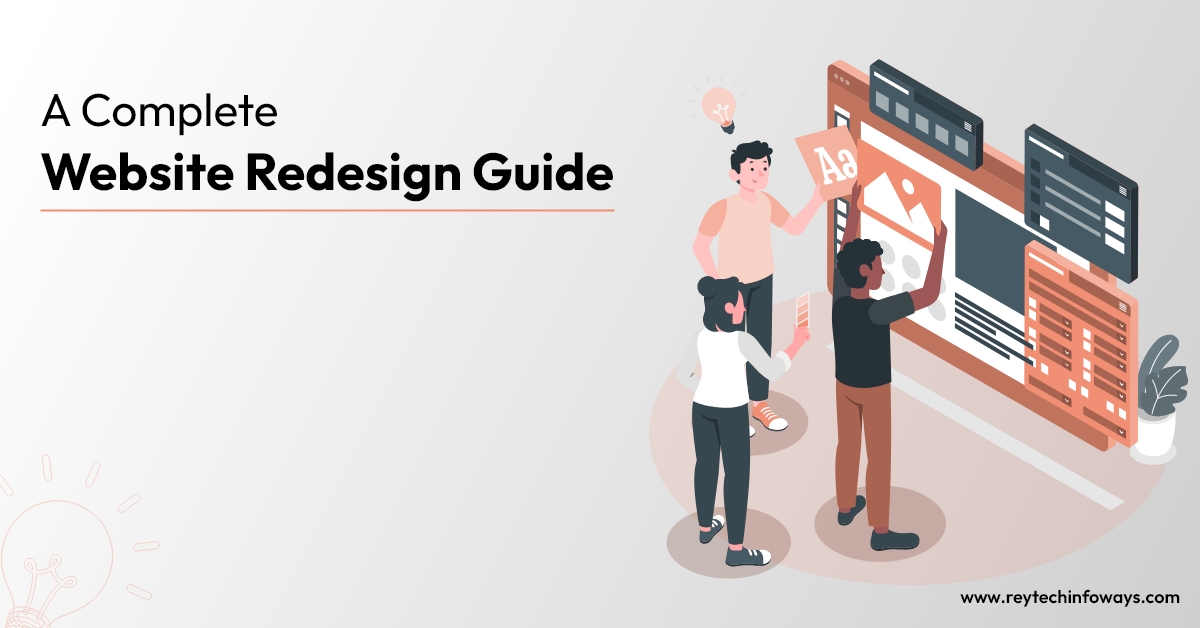Web Development
A Complete Website Redesign Guide!

Introduction
Web design and development are vital in constructing and preserving a thriving online sight in today's digital age. Web design primarily concentrates on a website's aesthetics, user interface, and general look and feel. It concerns carefully choosing colours, typography, images, and layout to develop a visually attractive and user-friendly interface.
A well-designed website catches visitors' attention and improves their knowledge by completing navigation that is intuitive and easily accessible. On the other hand, web product is the specialized aspect of structure and keeping a website. It involves using diverse programming languages and technologies to bring the technique to life and make it available.
Web designers work on the end of websites, guaranteeing that they load quickly, function smoothly, and are consistent with different browsers and devices. They also manage databases, server configurations, and the integration of interactive components such as forms, e-commerce functionalities, and content management systems.
Web design is the exhaustive procedure of strategizing, imagining, and running a blueprint to build a website that is both practical and delivers an optimal user experience. The focal point of web design rotates around providing positive user interaction. Websites contain a myriad set of features meticulously finagled to promote seamless navigation.
In essence, web design entails carefully refining every aspect of a website that users encounter, resulting in a streamlined andeffective medium. This system allows users to discover the desired details swiftly while guaranteeing an aesthetically attractive visual presentation. When all these components are harmoniously blended, they collectively resolve the quality of the website's design.
The benefits of website redesign
Opting for a complete website redesign suggests long-term benefits over temporary fixes or temporary solutions. Rather than repeatedly instilling short-term patches, a redesign permits you to specify a solid foundation immediately.
By thoroughly assessing your present website, you can identify prospects to enrich the user experience and usability, boosting conversions and revenue. Besides, a redesign authorizes one to hold a cohesive brand identity, securing character across all updates and improvements.
It's also an excellent moment to increase SEO performance, aligning your content with your user pursuit plan. Simultaneously, a restored content strategy can achieve the redesigned website, creating a pleasant and modern digital presence.
Similarly, a website overhaul can optimize site arrangement, improve technical aspects, improve security, and defend responsiveness across various screen sizes. Assuming these benefits enhances user fulfillment and reinforces your brand's online existence and competitiveness in the digital terrain.
The steps involved in website redesign
To essay on a triumphant website redesign process, it is necessary to begin with detailed user research and a complete analysis of your current website. This initial step lays the ground for pinpointing places that require improvement. The study should possess four essential parts.
Evaluate the user-friendliness of your existing website. Consider your website's content's quality, applicability, and organization. Execute an SEO audit to gauge the website's interpretation of search engine rankings. Examine the website's transformation pathways and reckon how effectively it transforms visitors into customers or achieves other desired actions.
Tips for successful website redesign
In the method of website redesign, several vital missteps should be detoured to ensure the significance and success of the project. First and foremost, prioritizing responsiveness is essential, as a giant portion of web traffic now comes from mobile devices. You must optimize for different screen sizes and resolutions to secure a good user experience.
Secondly, establishing clear and achievable objectives for the redesign is essential. Without a specified purpose, the project can lack principle and efficiency. Technology preference is another critical review, as it should align with the project's goals and forthcoming scalability.
Developing a well-planned redesign approach is also vital. Skipping this step can lead to random changes and inefficiencies. Ignoring content in favor of design is a typical mistake, as fascinating content is crucial for user interest and retention.
Further, overstuffing the website with disproportionate images and the tiniest text can harm SEO and user experience. Complicated navigation should also be streamlined for improved usability. Lastly, compromising user knowledge for aesthetics can lead to slow loading times and hinder Accessibility. Avoiding these website redesign blunders and concentrating on user-centric design, SEO optimization, and strategic planning can lead to a successful website transformation.
Conclusion
Maintaining a well-designed website is paramount for businesses in the ever-evolving digital landscape. However, the rack life of a website has significantly shortened in contemporary years due to the constant influx of new trends and technologies. Consequently, businesses are often compelled to redesign websites to stay competitive and aligned with market needs. Nevertheless, standard website blunders can sabotage a triumphant redesign.
To provide a fruitful website redesign process, avoiding these hitches is binding. Your website processes as your corporation's online facade, making it vital to remain attuned to the latest trends and technologies. By bypassing these website redesign blunders, you can protect your online sight from probable knocks.